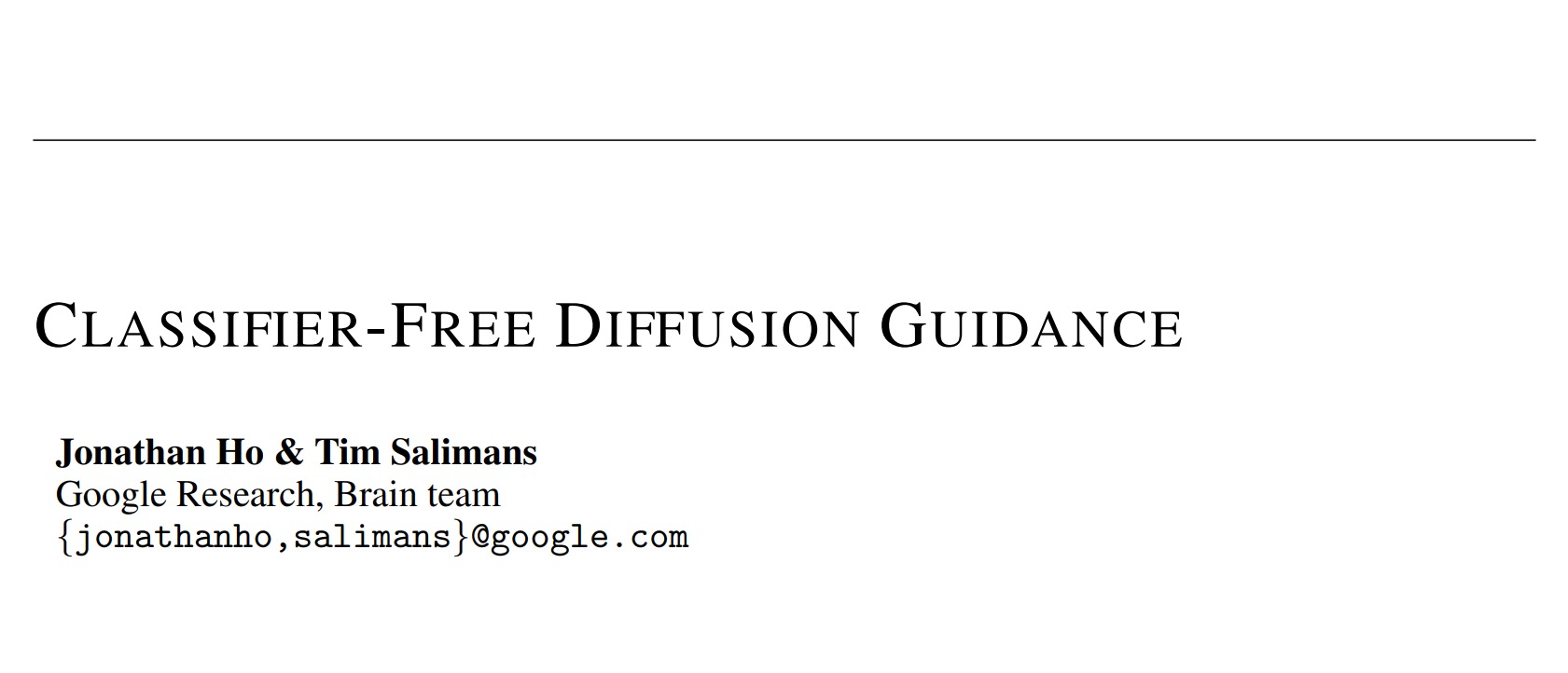基于语义扩散引导的图像合成.
本文提出了一种实现条件扩散模型的语义扩散引导(Semantic Diffusion Guidance)方法。实现扩散模型的一般思路:
- 定义前向扩散过程:\(q\left(\mathbf{x}_t \mid \mathbf{x}_{t-1}\right)\)
- 解析地推导:\(q\left(\mathbf{x}_t \mid \mathbf{x}_{0}\right)\)
- 解析地推导:\(q\left(\mathbf{x}_{t-1} \mid \mathbf{x}_t,\mathbf{x}_{0}\right)\)
- 近似反向扩散过程:\(p_{\theta}\left(\mathbf{x}_{t-1} \mid \mathbf{x}_t\right)\)
条件扩散模型是指在采样过程\(p_{\theta}\left(\mathbf{x}_{t-1} \mid \mathbf{x}_t\right)\)中引入输入条件\(\mathbf{y}\),则采样过程变为\(p_{\theta}\left(\mathbf{x}_{t-1} \mid \mathbf{x}_t,\mathbf{y}\right)\)。为了重用训练好的模型\(p_{\theta}\left(\mathbf{x}_{t-1} \mid \mathbf{x}_t\right)\),定义:
\[\begin{aligned} p_{\theta}\left(\mathbf{x}_{t-1} \mid \mathbf{x}_t,\mathbf{y}\right) &= \frac{p_{\theta}\left(\mathbf{x}_{t-1} \mid \mathbf{x}_t\right)e^{\gamma \cdot \text{sim}(\mathbf{x}_{t-1},\mathbf{y})}}{Z(\mathbf{x}_t,\mathbf{y})} \\ Z(\mathbf{x}_t,\mathbf{y}) &= \sum_{\mathbf{x}_{t-1}} p_{\theta}\left(\mathbf{x}_{t-1} \mid \mathbf{x}_t\right)e^{\gamma \cdot \text{sim}(\mathbf{x}_{t-1},\mathbf{y})} \end{aligned}\]其中\(\text{sim}(\mathbf{x}_{t-1},\mathbf{y})\)是生成结果\(\mathbf{x}_{t-1}\)和输入条件\(\mathbf{y}\)之间的相似性度量,$\gamma$控制结果与条件的相关性。
为了进一步得到可采样的近似结果,在\(\mathbf{x}_{t-1}=\boldsymbol{\mu}_\theta\left(\mathbf{x}_t, t\right)\)处考虑泰勒展开:
\[\begin{aligned} e^{\gamma \cdot \text{sim}(\mathbf{x}_{t-1},\mathbf{y})} \approx e^{\gamma \cdot \text{sim}(\mathbf{x}_t,\mathbf{y})+ \gamma(\mathbf{x}_{t-1}-\boldsymbol{\mu}_\theta\left(\mathbf{x}_t, t\right)) \cdot \nabla_{\mathbf{x}_t} \text{sim}(\mathbf{x}_t,\mathbf{y}) + \mathcal{O}(\mathbf{x}_t) } \end{aligned}\]并注意到反向扩散过程的建模:
\[\begin{aligned} p_\theta\left(\mathbf{x}_{t-1} \mid \mathbf{x}_t\right)&=\mathcal{N}\left(\mathbf{x}_{t-1} ; \boldsymbol{\mu}_\theta\left(\mathbf{x}_t, t\right), \sigma_t^2 \mathbf{I}\right) \\ \end{aligned}\]因此有:
\[\begin{aligned} p_{\theta}\left(\mathbf{x}_{t-1} \mid \mathbf{x}_t,\mathbf{y}\right) &\propto p_{\theta}\left(\mathbf{x}_{t-1} \mid \mathbf{x}_t\right)e^{\gamma \cdot \text{sim}(\mathbf{x}_{t-1},\mathbf{y})} \\ &\propto \exp\left(-\frac{\left\| \mathbf{x}_{t-1} -\boldsymbol{\mu}_\theta\left(\mathbf{x}_t, t\right) \right\|^2}{2\sigma_t^2}+\gamma(\mathbf{x}_{t-1}-\boldsymbol{\mu}_\theta\left(\mathbf{x}_t, t\right)) \cdot \nabla_{\mathbf{x}_t} \text{sim}(\mathbf{x}_t,\mathbf{y}) + \mathcal{O}(\mathbf{x}_t) + \mathcal{O}(\mathbf{x}_t) \right) \\ &\propto \exp\left(-\frac{\left\| \mathbf{x}_{t-1} -\boldsymbol{\mu}_\theta\left(\mathbf{x}_t, t\right)-\sigma_t^2 \gamma \nabla_{\mathbf{x}_t} \text{sim}(\mathbf{x}_t,\mathbf{y})\right\|^2}{2\sigma_t^2} + \mathcal{O}(\mathbf{x}_t) \right) \\ \end{aligned}\]则\(p_{\theta}\left(\mathbf{x}_{t-1} \mid \mathbf{x}_t,\mathbf{y}\right)\)近似服从正态分布:
\[\begin{aligned} p_{\theta}\left(\mathbf{x}_{t-1} \mid \mathbf{x}_t,\mathbf{y}\right)=\mathcal{N}\left(\mathbf{x}_{t-1} ; \boldsymbol{\mu}_\theta\left(\mathbf{x}_t, t\right)+\sigma_t^2 \gamma \nabla_{\mathbf{x}_t} \text{sim}(\mathbf{x}_t,\mathbf{y}), \sigma_t^2 \mathbf{I}\right) \\ \end{aligned}\]因此条件扩散模型\(p_{\theta}\left(\mathbf{x}_{t-1} \mid \mathbf{x}_t,\mathbf{y}\right)\)的采样过程为:
\[\mathbf{x}_{t-1} = \boldsymbol{\mu}_\theta\left(\mathbf{x}_t, t\right)+\underbrace{\sigma_t^2 \gamma \nabla_{\mathbf{x}_t} \text{sim}(\mathbf{x}_t,\mathbf{y})|_{\mathbf{x}_t=\boldsymbol{\mu}_\theta\left(\mathbf{x}_t, t\right)}}_{\text{新增项}}+ \sigma_t \mathbf{z},\mathbf{z} \sim \mathcal{N}\left(\mathbf{0}, \mathbf{I}\right)\]因此实现条件扩散模型,只需要直接定义度量函数\(\text{sim}(\mathbf{x}_t,\mathbf{y})\)即可。通常的处理方式是用各自的编码器(\(\mathbf{x}_t\):图像;\(\mathbf{y}\):图像、文本、类别等)将其编码为特征向量,然后用余弦相似度计算:
\[\text{sim}(\mathbf{x}_t,\mathbf{y}) = \frac{E_1(\mathbf{x}_t)\cdot E_2(\mathbf{y})}{\left\|E_1(\mathbf{x}_t)\right\|\left\|E_2(\mathbf{y})\right\|}\]值得一提的是,由于\(\mathbf{x}_t\)是带高斯噪声的,所以编码器$E1$一般不能直接调用干净数据训练的编码器,而是要用加噪声后的数据对它进行微调才比较好。


